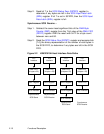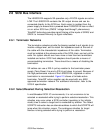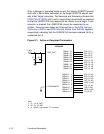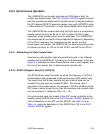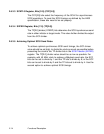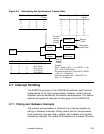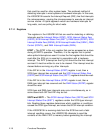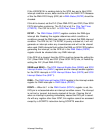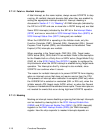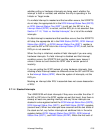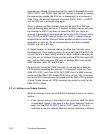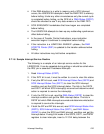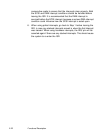
2-16 Functional Description
that could be used for other system tasks. The preferred method of
detecting interrupts in most systems is hardware interrupts. In this case,
the LSI53C810A asserts the Interrupt Request (IRQ/) line that interrupts
the microprocessor, causing the microprocessor to execute an interrupt
service routine. A hybrid approach would use hardware interrupts for
long waits, and use polling for short waits.
2.7.1.1 Registers
The registers in the LSI53C810A that are used for detecting or defining
interrupts are the Interrupt Status (ISTAT), SCSI Interrupt Status Zero
(SIST0), SCSI Interrupt Status One (SIST1), DMA Status (DSTAT), SCSI
Interrupt Enable Zero (SIEN0), SCSI Interrupt Enable One (SIEN1), DMA
Control (DCNTL), and DMA Interrupt Enable (DIEN).
ISTAT – The ISTAT is the only register that can be accessed as a slave
during SCRIPTS operation. Therefore, it is the register that is polled
when polled interrupts are used. It is also the first register that should be
read after the IRQ/ pin is asserted in association with a hardware
interrupt. The INTF (Interrupt-on-the-Fly) bit should be the first interrupt
serviced. It must be written to one to be cleared. This interrupt must be
cleared before servicing any other interrupts.
If the SIP bit in the Interrupt Status (ISTAT) register is set, then a
SCSI-type interrupt has occurred and the SCSI Interrupt Status Zero
(SIST0) and SCSI Interrupt Status One (SIST1) registers should be read.
If the DIP bit in the Interrupt Status (ISTAT) register is set, then a
DMA-type interrupt has occurred and the DMA Status (DSTAT) register
should be read.
SCSI-type and DMA-type interrupts may occur simultaneously, so in
some cases both SIP and DIP may be set.
SIST0 and SIST1 – The SCSI Interrupt Status Zero (SIST0) and SCSI
Interrupt Status One (SIST1) registers contain the SCSI-type interrupt
bits. Reading these registers determines which condition or conditions
caused the SCSI-type interrupt, and clears that SCSI interrupt condition.
If the LSI53C810A is receiving data from the SCSI bus and a fatal
interrupt condition occurs, the LSI53C810A attempts to send the
contents of the DMA FIFO to memory before generating the interrupt.





